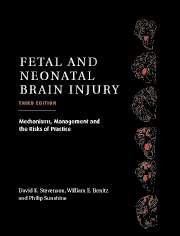Book contents
- Frontmatter
- Contents
- List of contributors
- Foreword
- Preface
- Part I Epidemiology, Pathophysiology, and Pathogenesis of Fetal and Neonatal Brain Injury
- Part II Pregnancy, Labor, and Delivery Complications Causing Brain Injury
- Part III Diagnosis of the Infant with Asphyxia
- Part IV Specific Conditions Associated with Fetal and Neonatal Brain Injury
- 26 Hypoglycemia in the neonate
- 27 Hyperbilirubinemia and kernicterus
- 28 Polycythemia
- 29 Hydrops fetalis
- 30 Acidosis/alkalosis
- 31 Meconium staining and the meconium aspiration syndrome
- 32 Persistent pulmonary hypertension of the newborn
- 33 Pediatric cardiac surgery: relevance to fetal and neonatal brain injury
- Part V Management of the Depressed or Neurologically Dysfunctional Neonate
- Part VI Assessing the Outcome of the Asphyxiated Infant
- Index
- Plate section
28 - Polycythemia
from Part IV - Specific Conditions Associated with Fetal and Neonatal Brain Injury
Published online by Cambridge University Press: 10 November 2010
- Frontmatter
- Contents
- List of contributors
- Foreword
- Preface
- Part I Epidemiology, Pathophysiology, and Pathogenesis of Fetal and Neonatal Brain Injury
- Part II Pregnancy, Labor, and Delivery Complications Causing Brain Injury
- Part III Diagnosis of the Infant with Asphyxia
- Part IV Specific Conditions Associated with Fetal and Neonatal Brain Injury
- 26 Hypoglycemia in the neonate
- 27 Hyperbilirubinemia and kernicterus
- 28 Polycythemia
- 29 Hydrops fetalis
- 30 Acidosis/alkalosis
- 31 Meconium staining and the meconium aspiration syndrome
- 32 Persistent pulmonary hypertension of the newborn
- 33 Pediatric cardiac surgery: relevance to fetal and neonatal brain injury
- Part V Management of the Depressed or Neurologically Dysfunctional Neonate
- Part VI Assessing the Outcome of the Asphyxiated Infant
- Index
- Plate section
Summary
Introduction
Polycythemia and hyperviscosity were first associated with adverse neurologic events and sequelae in a series of case reports. The first case often referenced was published by Wood in 1952 and was followed by a small series of infants with polycythemia and hyperviscosity who displayed multiple problems, including cerebral dysfunction. Since those early reports it has become clear that polycythemia has multiple etiologies which influence whether and which problems may be associated with it in the newborn period. In addition more recent animal and human studies have clarified the relationship between polycythemia and alterations in function of various organs.
Definition
Polycythemia is usually defined in the literature as a hematocrit value ≥ 65% when the blood sample is obtained from a free-flowing, large venous blood vessel such as the inferior vena cava (umbilical vein sample) spun in a centrifuge. Sampling from small vessels with low flow or capillary samples will have higher values. In addition, hematocrits calculated by a Coulter counter will yield comparatively lower values. Independent of sample site or measurement technique, the hematocrit increases over the first 2–4 h of life, gradually returning to the birth value by 12–24 h of age.
Incidence
The incidence of polycythemia varies by definition, altitude of the population, pregnancy risk factors, and techniques involved in the delivery of the fetus, and timing and sampling sites of blood samples.
- Type
- Chapter
- Information
- Fetal and Neonatal Brain InjuryMechanisms, Management and the Risks of Practice, pp. 578 - 585Publisher: Cambridge University PressPrint publication year: 2003



